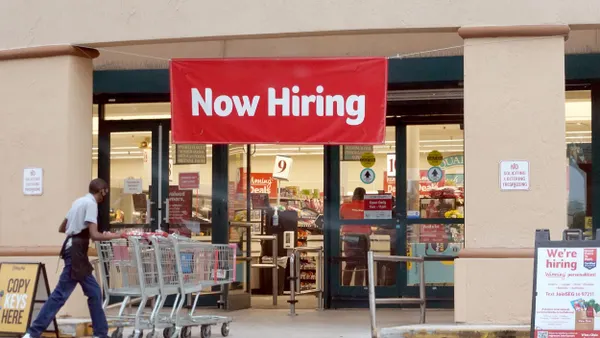Dive Brief:
- Hiring intentions among U.S. employers are at a 12-year high entering the first quarter of 2019, according to the latest ManpowerGroup Employment Outlook Survey. U.S. employers reported a 20% increase in recruiting confidence, and more than 12,500 employers in all four regions of the country forecasted double-digit-percentage hiring outlooks.
- The industries in which employers had the highest forecasted hiring growth were: transportation and utilities (28%); leisure and hospitality (27%); professional and business services (25%); and wholesale and retail trade (24%). Regionally, the South had the highest growth outlook (21%), followed by the Northeast, West and Midwest with 20% each.
- "Increased employer optimism tells us employers have jobs to fill, yet we know they are struggling to find the talent they need from production line workers to IT professionals," Becky Frankiewicz, president of ManpowerGroup North America, said in a statement. "With so many U.S. organizations set to hire in an already tight labor market, skilled workers can call the shots. For some workers benefits including childcare facilities, free transportation, or the offer of certification and career progression are key."
Dive Insight:
Despite a slowdown last month, U.S. unemployment is still at historic lows, which may translate to a continuation of present talent strains for the foreseeable future. But employees are not only driving the labor market, they're also influencing the workplace policies and driving the pay levels, benefits and programs organizations are using to hire and keep them.
Flexible work schedules, career development opportunities, paid parental leave and remote work options emerge in study after study as employees' most wanted perks. Although pay remains the top job attraction, wages have remained relatively stagnant for several consecutive months. As the search for skilled workers grows more competitive, large organizations, as Frankiewicz noted, are paying a premium, be it in wages or additional compensation, to fill certain positions.
Employers also might find it necessary to develop a more positive employee experience for their recruitment and retention strategy. These efforts, which may necessitate a broader cultural overhaul, include a focus on employee recognition and wellbeing, diversity and inclusion, and meaningful work as components of the employee value proposition.












